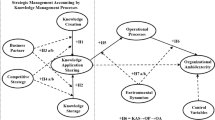The objective of this article is to discuss the learning organisation (LO) concept in correlation with network organisation (NO), which is an indispensable element for the transition into the new era of management, i.e. knowledge networking. Business organisations (BO) rarely achieve innovativeness, and thus competitive advantage, without establishing NO/LO and knowledge management. Therefore, a suitable knowledge strategy must be developed that is related to BO's business strategy. The last two statements surface our main hypothesis, which is described in our general model on linking the elements of an LO and then tested by empirical research carried out in Slovenian BOs. Our original model of LO has proved helpful in understanding BOs as LOs in transitional economies, e.g. in Slovenia. In them an innovation-based business has not yet become the norm with BOs of all sizes, with success mainly enjoyed in larger BOs. However, NO can help the LO concept spread and support innovativeness rather quickly in all BOs.





Similar content being viewed by others
Notes
Variety within an organisation must be at least equal to, or greater than, the variety and complexity of the environment so that the organisation can face fluctuation from the environment (summary of the Ashby law of the requisite variety). Every coworker needs quick access to a large variety of the information and means in order to increase the variety.
Viable systems theory, as a rule, does not prescribe the contents of an organisational structure. It is more interested in the research of essence in the BO's representing a sequence of different interdependent connections, and in maintenance of BO's identity.
Analysis of the results of all BOs responding to our questionnaire (questions from the questionnaire, discontent index), % of all BOs taking part in our survey by individual groups of estimation from 0 to 5 (i.e. 0—I do not know, have no information; 1—No, or I do not agree at all; 2—Badly; 3—Not badly and not well; 4—Well and I agree; 5—excellent and I agree completely). The questionnaire comprises different statements, questions or elements. Each of them is divided into two more parts (subquestions): 1. “How is it?,” or a current situation of the organisation in concern to individual statement or question; 2. “What do you wish it to be like?” or the effort or future ideal organisation for each statement, element or question. The discontent index is a major criterion for each LO's field or characteristic. It is expressed as the relation defined on the basis of answers to two different subquestions for each of the statements and questions of the questionnaire in concern to LO (B-A/5). The use of such a relation is more valuable in practice, than classifying answers to subquestions for each statement and question. The discontent index is from 0% (absolutely content) to 100% (absolutely discontent). (http://ehostvgw.2epnet.com/fulltext.asp).
According to the criterion of employees number up to 50 employees small, 51–250 employees medium-sized and over 250 employees large companies.
REFERENCES
Beer, S. (1979). The Heart of Enterprise, Wiley, Chichester.
Berginc, J. (ed.) (2004). Business Meeting with Slovenians from Abroad and Slovenia. Sponsored by Government of Slovenia, Office for Structural Policy and Regional Development, in Ljubljana, on 09 July, 2004 (tape-recorded).
Ecimovic, T., et al. (2002). Systems Thinking and Climate Change System, SEM Institute for Climate Change, Korte.
Flood, L. R. (1991). Liberating System Theory, Plenum, New York.
Flood, L. R., and Jackson, M. (1991). Critical Problem Solving, Wiley, Chichester.
Flood, R. L. (1999). Rethinking the Fifth Discipline: Learning Within the Unknowable, Routledge, London.
Garvin, D. A. (1998). Building a learning organization. Harward Business Review on Knowledge Management, 47–80.
Jensen, R. (2003). Sanjska družba II. Viharjenje srca = Heartstorm, New Moment, Ljubljana.
Marquardt, M. J. (1996). Building the Learning Organization: A Systems Approach to Quantum Improvement and Global Success, McGraw-Hill, New York.
Mulej, M. et al. (1994). Inovacijski Management, Univerza v Mariboru, Ekonomsko-poslovna fakulteta Maribor, Maribor.
Mulej, M. et al. (2005). Increasing the capacity of companies to absorb inventions from research organizations and encouraging people to innovate. Cybern. Syst. 36(5), 491–512.
Mulej, M., and Zenko, Z. (2004). Dialekticna teorija sistemov in invencijsko-inovacijski management, Management Forum, Maribor.
Mulej, M. et al. (2004). How to restore Bertalanffian systems thinking. Kybernetes: Int. J. Syst. Cybern. 33(1), 48–61.
Nikl, A. (2003). Organizacijsko ucenje in sinergijski ucinki v managementu. Masters Degree thesis, Ekonomsko-poslovna fakulteta, Maribor.
Nonaka, I., and Takeuchi, H. (1995). The Knowledge Creating Company, Oxford University Press, NY.
Pirc, A. S. (2000). Organizational Learning and Knowledge Management. Masters Degree thesis, Ekonomska fakulteta, Ljubljana.
Thommen, J.-P. et al. (1998). Sinergija in razvojni management, MER Evrocenter, Gubno.
Ursic, D., and Mulej, M. (2005). Theory and practice of management concepts—Slovenia's experiences. J. Manag. Dev. 24(10).
Ursic, D. (1996). Inoviranje podjetja-sistemsko-organizacijski vidik (Innovation of Enterprise–systems-organisational approach), Studio Linea, Maribor.
Ursic, D. (2001). Modeliranje organizacije (Modeling of Organisation), Univerza v Mariboru, Ekonomsko-poslovna fakulteta Maribor, Maribor.
Ursic, D., and Nikl, A. (2004). Učeča se organizacija–sistemsko-organizacijski vidik, (Learning Organisation–systems-organisational approach), Management Forum, Maribor.
Ursic, D. et al. (2005). The steps towards successful reengineering in Slovenian companies. Management (Split) 10(1), 51–57.
Waldersee, R. (1997). Becoming a learning organization: The transformation of the workforce. J. Manag. Dev. 16(4), 262–273.
Author information
Authors and Affiliations
Corresponding author
Rights and permissions
About this article
Cite this article
Ursic, D., Nikl, A., Mulej, M. et al. System-Organisational Aspect of a Learning Organisation in Companies. Syst Pract Act Res 19, 81–99 (2006). https://doi.org/10.1007/s11213-005-9005-1
Received:
Accepted:
Published:
Issue Date:
DOI: https://doi.org/10.1007/s11213-005-9005-1




